Jonah rented a car for two days and his bill came to $108.00 . The rental company charged $30 a day and 15cancelc for each mile driven. If x is the number of miles that Jonah drove , which equation correctly determines x ?
30x+15(2)=108
0.15x+30(2)=108
15x+30(2)=108
15x+30(2)=10,800
The correct Answer is:B
Step by step video, text & image solution for Jonah rented a car for two days and his bill came to $108.00 . The rental company charged $30 a day and 15cancelc for each mile driven. If x is the number of miles that Jonah drove , which equation correctly determines x ? by Maths experts to help you in doubts & scoring excellent marks in Class 12 exams.
Topper's Solved these Questions
Similar Questions
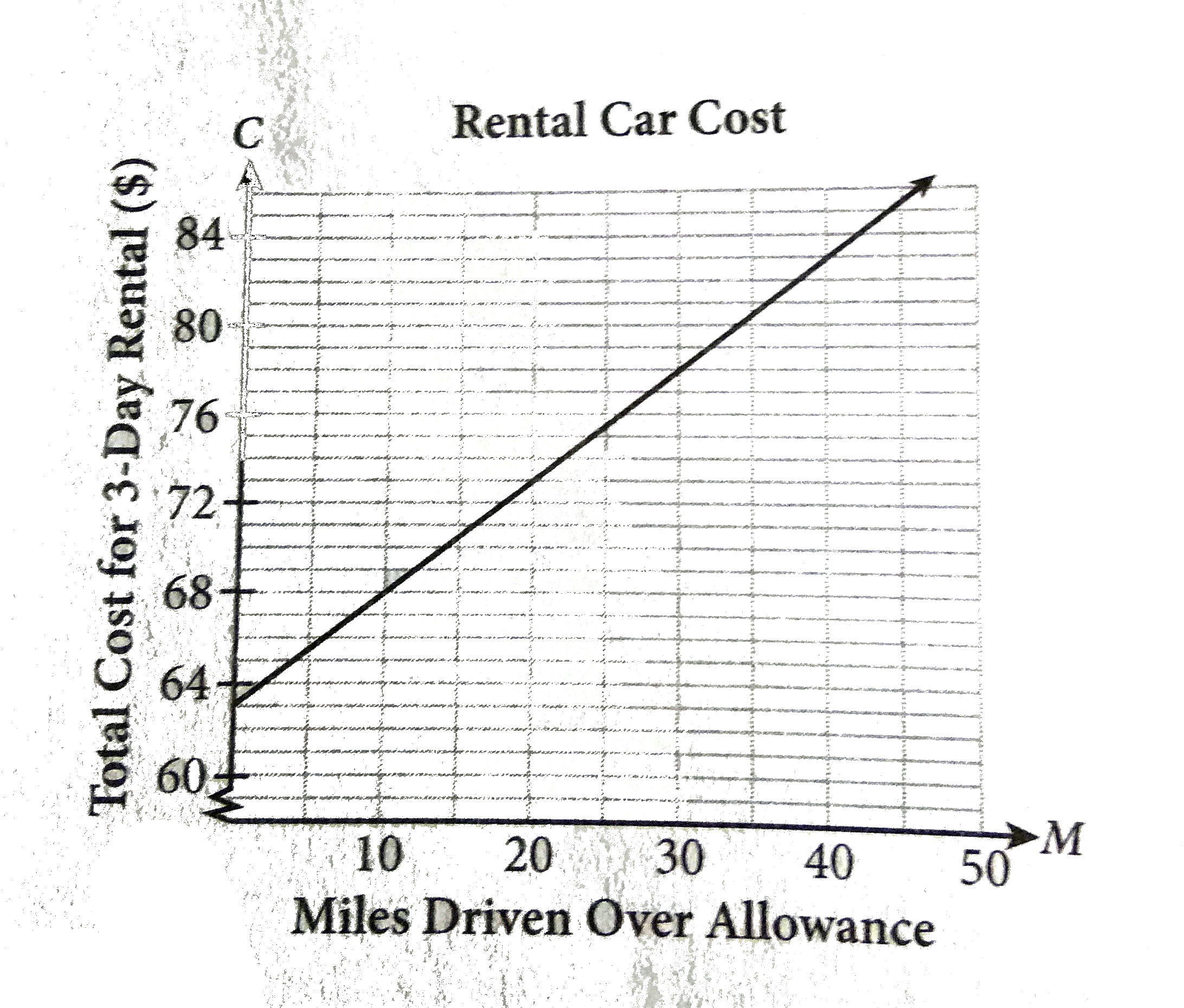
A car retal agency charges a per day rental fee which includes a daily mile age allowance plus a certain amount per mile driven over the allowance. The graph above compares the miles driven over the allowance and the total cost for a 3-day rental. What does the C-intercept most likely represent in this scenario?View SolutionAt both Quick Car Rental and Speedy Car Rental, the cost, in dollars, of renting a full - size car depends on a fixed daily rental fee and a fixed charge per mile that the car is driven. However, the daily rental fee and the charge per mile are not the same for the 2 companies. In the graph below, line Q represents the total cost for Quick Car Rental and line S represents the total cost for Speedy Car Rental.
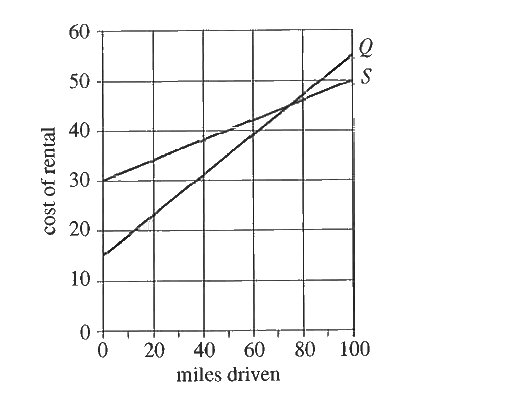
Robert plans to rent a full-size car for 1 day and drive only 50 miles. If his only consideration is to incur the least cost, which company should he choose?View Solution
Knowledge Check
- Question 1 - Select One
After visiting Florida State University during spring break, Francisco rents a car for 2 days to travel around Florida. He has $255 to spend on car rental for the 2 days. Sea horse Car Rental charges $50 per day and $0.25 per mile. Ocean Blue Car Rental charges $60 per day and $0.20 per mile. Which company, if either, allows him to travel more miles for the 2 days, and how many miles more?
(Note: Taxes are already included in the rental charges)ASea-Horse, 20BOcean Blue, 55COcean Blue, 100DSea Horse, 135 - Question 2 - Select One
y = 19.99 + 1.50x
The equation above models the total cost y, in dollars, that a company charges a customer to rent a truck for one day and drive the truck x miles. The total cost consists of a flat fee plus a charge per mile driven. When the equation is graphed in the xy-plane, what does the y-intercept of the graph represent in terms of the model?AA flat fee of $19.99BA charge per mile of $1.50CA charge per mile of $19.99DTotal daily charges of $21.49 - Question 3 - Select One
At both Quick Car Rental and Speedy Car Rental, the cost, in dollars, of renting a full - size car depends on a fixed daily rental fee and a fixed charge per mile that the car is driven. However, the daily rental fee and the charge per mile are not the same for the 2 companies. In the graph below, line Q represents the total cost for Quick Car Rental and line S represents the total cost for Speedy Car Rental.
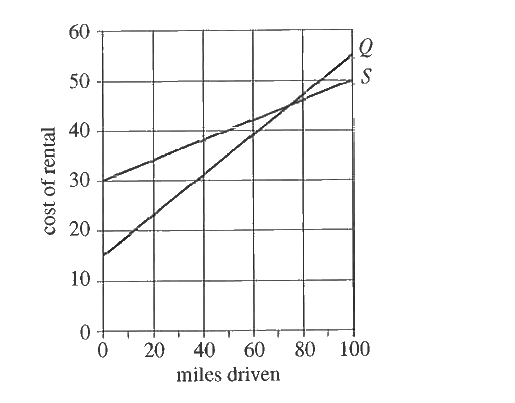
If you rent a full-size car from Quick Car Rental for 1 day, how much more would the total rental cost be if you drove the car 78 miles than if you drove it 77 miles?A$0.10B$0.15C$0.20D$0.40
At both Quick Car Rental and Speedy Car Rental, the cost, in dollars, of renting a full - size car depends on a fixed daily rental fee and a fixed charge per mile that the car is driven. However, the daily rental fee and the charge per mile are not the same for the 2 companies. In the graph below, line Q represents the total cost for Quick Car Rental and line S represents the total cost for Speedy Car Rental.

What would be the total cost of renting a full-size car from Speedy Car Rental for 1 day and driving the car 150 miles?View SolutionMr. Martinson is building a concrete patio in his backyard and deciding where to buy the materials and rent the tools needed for the project. The table below shows the materials’ cost and daily rental costs for three different stores.

The total cost, y, for buying the materials and renting the tools in terms of the number of days, x, is given by y=M+(W+K)x .
If the relationship between the total cost, y, of buying the materials and renting the tools at Store C and the number of days, x, for which the tools are rented is graphed in the xy-plane, what does the slope of the line represent?View Solution15x+90x+30=2
The equation above represents the following situation. On his way home from college , Juan traveled 15 miles on local roads and 90 miles on the highway. On the highway he traveled 30 miles per hour faster than on local roads . The whole trip took 2 hours. Which of the following describes what the expression 90x+30 represents in the equation ?View SolutionThough there are 600 million cars on the planet, and counting, there are also seven billion people, which means that for the vast majority of us getting
around involves taking buses, ferryboats, commuter
line 5-trains, streetcars, and subways. In other words, traveling to work, school, or the market means being a straphanger: somebody who, by choice or necessity, relies on public transport, rather than a privately owned automobile.
line 10- Half the population of New York, Toronto, and London do not own cars. Public transport is how most of the people of Asia and Africa, the world’s most populous continents, travel. Every day, subway systems carry 155 million passengers, thirty-four
line 15- times the number carried by all the world’s airplanes, and the global public transport market is now valued at $428 billion annually. A century and a half after the invention of the internal combustion engine, private car ownership is still an anomaly.
line 20- And yet public transportation, in many minds, is the opposite of glamour—a squalid last resort for those with one too many impaired driving charges, too poor to afford insurance, or too decrepit to get behind the wheel of a car. In much of North
line 25- America, they are right: taking transit is a depressing experience. Anybody who has waited far too long on a street corner for the privilege of boarding a lurching, overcrowded bus, or wrestled luggage onto subways and shuttles to get to a big city airport,
line 30- knows that transit on this continent tends to be underfunded, ill-maintained, and ill-planned. Given the opportunity, who wouldn’t drive? Hopping in a car almost always gets you to your destination more quickly.
line 35- It doesn’t have to be like this. Done right, public transport can be faster, more comfortable, and cheaper than the private automobile. In Shanghai, German-made magnetic levitation trains skim over elevated tracks at 266 miles an hour, whisking people
line 40 - to the airport at a third of the speed of sound. In provincial French towns, electric-powered streetcars run silently on rubber tires, sliding through narrow streets along a single guide rail set into cobblestones. From Spain to Sweden, Wi-Fi equipped high-speed
line 45- trains seamlessly connect with highly ramified metro networks, allowing commuters to work on laptops as they prepare for same-day meetings in once distant capital cities. In Latin America, China, and India, working people board fast-loading buses that move
line 50 - like subway trains along dedicated busways, leaving the sedans and SUVs of the rich mired in dawn-to-dusk traffic jams. And some cities have transformed their streets into cycle-path freeways, making giant strides in public health and safety and ltbr line 55- the sheer livability of their neighborhoods—in the process turning the workaday bicycle into a viable form of mass transit. If you credit the demographers, this transit trend has legs. The “Millenials,” who reached adulthood
line 60 - around the turn of the century and now outnumber baby boomers, tend to favor cities over suburbs, and are far more willing than their parents to ride buses and subways. Part of the reason is their ease with iPads, MP3 players, Kindles, and smartphones: you
line 65- can get some serious texting done when you’re not driving, and earbuds offer effective insulation from all but the most extreme commuting annoyances. Even though there are more teenagers in the country than ever, only ten million have a driver’s license
line 70 - (versus twelve million a generation ago). Baby boomers may have been raised in Leave It to Beaver suburbs, but as they retire, a significant contingent is favoring older cities and compact towns where they have the option of walking and riding bikes. Seniors
line 75- too, are more likely to use transit, and by 2025, there will be 64 million Americans over the age of sixty-five. Already, dwellings in older neighborhoods in Washington, D.C., Atlanta, and Denver, especially those near light-rail or subway stations, are
line 80 - commanding enormous price premiums over suburban homes. The experience of European and Asian cities shows that if you make buses, subways, and trains convenient, comfortable, fast, and safe, a surprisingly large percentage of citizens will opt to
line 85- ride rather than drive.
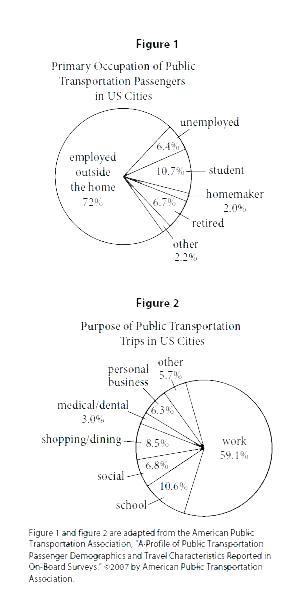
Which choice provides the best evidence for the answer to the previous question?View SolutionThough there are 600 million cars on the planet, and counting, there are also seven billion people, which means that for the vast majority of us getting
around involves taking buses, ferryboats, commuter
line 5-trains, streetcars, and subways. In other words, traveling to work, school, or the market means being a straphanger: somebody who, by choice or necessity, relies on public transport, rather than a privately owned automobile.
line 10- Half the population of New York, Toronto, and London do not own cars. Public transport is how most of the people of Asia and Africa, the world’s most populous continents, travel. Every day, subway systems carry 155 million passengers, thirty-four
line 15- times the number carried by all the world’s airplanes, and the global public transport market is now valued at $428 billion annually. A century and a half after the invention of the internal combustion engine, private car ownership is still an anomaly.
line 20- And yet public transportation, in many minds, is the opposite of glamour—a squalid last resort for those with one too many impaired driving charges, too poor to afford insurance, or too decrepit to get behind the wheel of a car. In much of North
line 25- America, they are right: taking transit is a depressing experience. Anybody who has waited far too long on a street corner for the privilege of boarding a lurching, overcrowded bus, or wrestled luggage onto subways and shuttles to get to a big city airport,
line 30- knows that transit on this continent tends to be underfunded, ill-maintained, and ill-planned. Given the opportunity, who wouldn’t drive? Hopping in a car almost always gets you to your destination more quickly.
line 35- It doesn’t have to be like this. Done right, public transport can be faster, more comfortable, and cheaper than the private automobile. In Shanghai, German-made magnetic levitation trains skim over elevated tracks at 266 miles an hour, whisking people
line 40 - to the airport at a third of the speed of sound. In provincial French towns, electric-powered streetcars run silently on rubber tires, sliding through narrow streets along a single guide rail set into cobblestones. From Spain to Sweden, Wi-Fi equipped high-speed
line 45- trains seamlessly connect with highly ramified metro networks, allowing commuters to work on laptops as they prepare for same-day meetings in once distant capital cities. In Latin America, China, and India, working people board fast-loading buses that move
line 50 - like subway trains along dedicated busways, leaving the sedans and SUVs of the rich mired in dawn-to-dusk traffic jams. And some cities have transformed their streets into cycle-path freeways, making giant strides in public health and safety and ltbr line 55- the sheer livability of their neighborhoods—in the process turning the workaday bicycle into a viable form of mass transit. If you credit the demographers, this transit trend has legs. The “Millenials,” who reached adulthood
line 60 - around the turn of the century and now outnumber baby boomers, tend to favor cities over suburbs, and are far more willing than their parents to ride buses and subways. Part of the reason is their ease with iPads, MP3 players, Kindles, and smartphones: you
line 65- can get some serious texting done when you’re not driving, and earbuds offer effective insulation from all but the most extreme commuting annoyances. Even though there are more teenagers in the country than ever, only ten million have a driver’s license
line 70 - (versus twelve million a generation ago). Baby boomers may have been raised in Leave It to Beaver suburbs, but as they retire, a significant contingent is favoring older cities and compact towns where they have the option of walking and riding bikes. Seniors
line 75- too, are more likely to use transit, and by 2025, there will be 64 million Americans over the age of sixty-five. Already, dwellings in older neighborhoods in Washington, D.C., Atlanta, and Denver, especially those near light-rail or subway stations, are
line 80 - commanding enormous price premiums over suburban homes. The experience of European and Asian cities shows that if you make buses, subways, and trains convenient, comfortable, fast, and safe, a surprisingly large percentage of citizens will opt to
line 85- ride rather than drive.
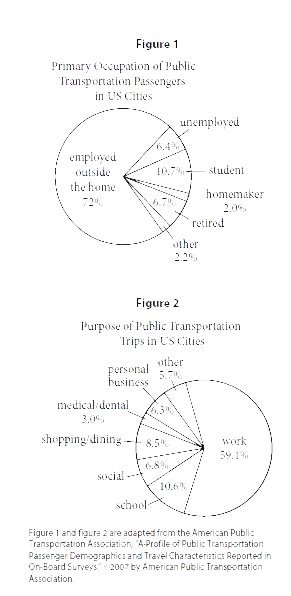
Which choice best supports the conclusion that public transportation is compatible with the use of personal electronic devices?View Solution
